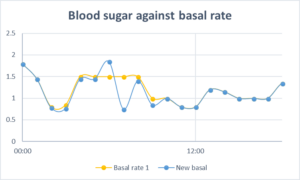Hardly a swan swimming serenely
The human body is an amazing machine, continually changing and adapting to its environment. This has led to our relatively slowly reproducing species to cover almost all of the planet and thrive.
When part of your body’s key metabolic functions is being supplied mechanically, this continual evolution can be hard to manage! As I don’t produce any insulin (or so little as to be ineffectual), part of my insulin replacement therapy is called the basal or background levels.
The basal is there to allow me to make use of my body’s release of energy stores (from the liver and muscles) for background functions, like breathing, waking up and moving.
This is currently where I find myself. Effectively, something has led to a fundamental change in my basal requirements. I can suggest this is because my bones have finally stopped healing or as they have, I have become more active, but ultimately, I am finding I have dramatically reduced my basal requirements. In the past week I have gone from 30.9 iu/day to 28.1 iu/day.
I suspect this is only the beginning of this process. Having made the changes seen below (from the yellow curve to the blue one) I suspect some more will be trimmed from my 10am basal rate to prevent the drop between 11 and 12am.
 This is an iterative process, if all goes well.
This is an iterative process, if all goes well.
Well? How? What???
To find my background levels, the easiest thing to do is to remove anything but the background functions from the equation.
In practice, that means food: coffee, tea, (if I smoked) cigarettes or anything that would require a bolus (or extra) dose of insulin.
Basically, to ensure my body is not stressed any further, meals are purposely missed along with anything that isn’t water. Dehydration causes stress to your body and that can alter the results coming out of the record. I limit myself to doing this three days out of seven to ensure fasting doesn’t cause stress either.
Having fasted over this period, you compare the blood sugar results you get over the period with your current insulin and modify that background insulin values to get something closer. The graph shows what I established last week on day two of the process – I’d lost 0.75 iu/day the day before following this process. I’d ended up with significantly less insulin though the 6am basal rate was a huge increase in dose.
Tools-wise, the basal rate estimator from the Insulin Pumpers site is the best I’ve seen. It shortens the process dramatically. Because I do this occasionally, it often requires me to tune back into how the tool works with which dose needs to be modified at which time.
Sounds straightforward…
I start with breakfast and work forward. As you can see from above, that lead to a dramatic change over two days.
Having established breakfast, I am now missing lunch. My work mates find it a little odd as I am still going to lunch with them – the walk to the canteen is part of my background requirements and I am sitting there with my bottle of fizzy water.
Any sudden drops or rises in blood glucose mean you have to stop the process and make the smaller change to prevent that for the next day.
As I said, I do have a drop at noon I need to sort out: it is unlikely to be caused by my breakfast bolus (as now concentrating on the afternoon levels), but that may be a necessary check I have to make (checking my ratios).
Even when I have the final basal period sorted (evening meal), I will then check my bolusing values for the three periods as that can changed.
Easy then…
Hopefully… just very time consuming <sigh>. Maybe a three to four week process.
Posted: May 2nd, 2018 under 42, Diabetes.

Comment from Sam Watkins
Time June 6, 2018 at 10:06 am
Stress is a major factor in altering control. As such, UK employment law protects diabetics going through such issues.